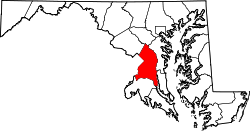Collington | |
|---|---|
defunct settlement | |
| Coordinates: 38°58′6″N76°45′35″W / 38.96833°N 76.75972°W | |
| Country | |
| State | |
| County | |
| Time zone | UTC-5 (Eastern (EST)) |
| • Summer (DST) | UTC-4 (EDT) |
| GNIS feature ID | 597266 |
Collington was a settlement in Prince George's County, Maryland, United States, dating from colonial times. [1] [2] Collington has been subsumed by the city of Bowie.

